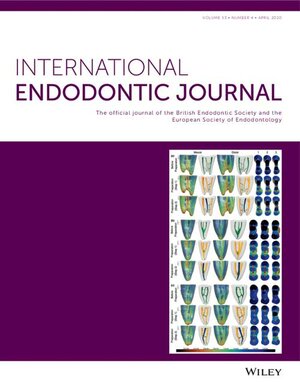Nanoparticulate bioceramic putty suppresses osteoclastogenesis and inflammatory bone loss in mice via inhibition of TRAF6-mediated signalling pathways: A laboratory investigation
Abstract
Aim
This study aimed to determine the effects of iRoot BP Plus on receptor activator of nuclear factor-κB ligand (RANKL)-induced osteoclastogenesis in vitro and inflammation-mediated bone resorption in vivo and investigated the underlying molecular mechanisms.
Methodology
CCK-8 was performed to test cell viability in RANKL-induced RAW 264.7 cells and BMDMs in response to iRoot BP Plus. The effect of iRoot BP Plus on osteoclastogenesis was determined using TRAP staining and phalloidin staining, respectively. Pit formation assay was conducted to measure osteoclast resorptive capacity. Western blot and qPCR were performed to examine osteoclast-related proteins and gene expression, respectively. Western blot was also used to investigate the signalling pathways involved. For in vivo experiments, an LPS-induced mouse calvarial bone resorption model was established to analyse the effect of iRoot BP Plus on bone resorption (n = 6 per group). At 7 days, mouse calvaria were collected and prepared for histological analysis.
Results
We identified that iRoot BP Plus extracts significantly attenuated RANKL-induced osteoclastogenesis, reduced sealing zone formation, restrained osteolytic capacity and decreased osteoclast-specific gene expression (p < .01). Mechanistically, iRoot BP Plus extracts reduced TRAF6 via proteasomal degradation, then suppressed the phosphorylation of mitogen-activated protein kinases (MAPKs), blocked the nuclear translocation of c-Fos and diminished nuclear factor-κB (NF-κB) p65 and NFATc1 accumulation. Consistent with the in vitro results, iRoot BP Plus extracts attenuated osteoclast activity thus protecting against inflammatory bone resorption in vivo (p < .05), which was accompanied by a suppression of TRAF6, c-Fos, NFATc1 and cathepsin K expression.
Conclusion
These findings provide valuable insights into the signalling mechanisms underlying nanoparticulate bioceramic putty-mediated bone homeostasis.

 求助内容:
求助内容: 应助结果提醒方式:
应助结果提醒方式:


